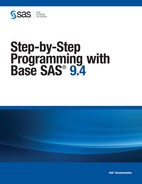Using a Quality Control Checklist
If
you follow some basic guidelines as you develop a program, then you
can avoid common errors. Use the following checklist to flag and correct
common mistakes before you submit your program.
-
SAS usually executes the statements in a DATA step one by one, in the order in which they appear. After executing the DATA step, SAS moves to the next step and continues in the same way. Make sure that all the SAS statements appear in order so that SAS can execute them properly. For example, an INFILE statement, if used, must precede an INPUT statement.
-
SAS classifies all variables as either character or numeric. The assignment in the INPUT statement as either character or numeric must correspond to the actual values of variables in your data. Also, SAS allows for list, column, formatted, or named input. The method of input that you specify in the INPUT statement must correspond with the actual arrangement of raw data.
..................Content has been hidden....................
You can't read the all page of ebook, please click here login for view all page.
